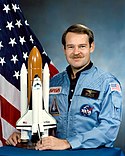John Creighton
| John Oliver Creighton | |
|---|---|
 | |
| Astronaut NASA | |
| Státní příslušnost | Spojené státy americké |
| Datum narození | 28. dubna 1943 (79 let) |
| Místo narození | Orange, Texas, USA |
| Předchozí zaměstnání | Zkušební pilot |
| Hodnost | Kapitán USN |
| Čas ve vesmíru | 16d 20h 24m |
| Kosmonaut od | 1978 |
| Mise | STS-51-G, STS-36, STS-48 |
| Znaky misí | |
| Některá data mohou pocházet z datové položky. | |
John Oliver Creighton (* 28. dubna 1943 v Orange, Texas, USA) je bývalý americký námořní letec a astronaut, který se účastnil letů s raketoplány.
Život
Mládí a výcvik
Po základní a střední škole absolvoval námořní akademii (United States Naval Academy), odkud si odnesl diplom inženýra. Stal se pak zkušebním pilotem v Naval Air Text Center Patuxent River ve státě Maryland. V době výběru do skupiny budoucích astronautů roku 1978 byl svobodný.[1]. Později si doplnil vzdělání na univerzitě ve Washingtonu (George Washington University).
Lety do vesmíru
Poprvé se zúčastnil sedmidenní mise STS-51-G na jaře roku 1985. Letěl na palubě Discovery spolu s touto posádkou: Daniel Brandenstein, Steven Nagel, John Fabian, Shannon Lucidová, francouzský astronaut Patrick Baudry a synovec saúdskoarabského krále princ Sultán Saiman Abdelazíz al-Saud. Vypustili na orbitě celou řadu družic – Spartan 1, Morelos 1A, Arabsat 1B, Telstar 3D. Provedli také experimenty pro program Hvězdných válek. V době svého letu se netajil s tím, že se po návratu ve svých 42 letech ožení (dle vyprávění astronauta Patricka Baudryho o celém letu v jeho knize Dnes vychází slunce šestnáctkrát, která koncem roku 1985 vyšla v Paříži).[2]
Druhá Johnova výprava do kosmu byla na palubě Atlantisu. Tato čtyřdenní mise patřila k utajovaným, vojenským letům. John Creighton byl velitelem, letěli s ním kolegové vesměs důstojníci John Casper, David Hilmers, Richard Mullane a Pierre Thuot. Během letu vypustili 17tunovou vojenskou, tedy špionážní družici USA-53 typu AFP-731.
Potřetí a naposled letěl na podzim roku 1991. Pětidenní mise STS-48 s raketoplánem Discovery se zúčastnili astronauti John Creighton, James Buchli, Kenneth Reightler, Charles Gemar a Mark Brown. Pětičlenná posádka během letu vypustila družici UARS. Zbytek letu byl věnován různým vědeckým pokusům.
Všechny tři lety měly start v Kennedyho vesmírném středisku na Floridě, mys Canaveral, přistání bylo na základně Edwards v Kalifornii.
Během tří svých letů strávil ve vesmíru 16 dní. Je zapsán jako 169. člověk ve vesmíru.
- STS-51-G Discovery (17. června 1985 – 24. června 1985)
- STS-36 Atlantis (28. února 1990 – 4. března 1990)
- STS-48 Discovery (12. září 1991 – 18. září 1991)
Po ukončení letů
Rok po svém třetím letu z NASA odešel a nastoupil na rok k firmě Boeing Co., Commercial Airplane Group, Seattle jako zkušební pilot.
Vyznamenání
Americká vyznamenání
 Defense Superior Service Medal
Defense Superior Service Medal Legion of Merit
Legion of Merit Distinguished Flying Cross
Distinguished Flying Cross Air Medal – uděleno desetkrát
Air Medal – uděleno desetkrát Armed Forces Expeditionary Medal
Armed Forces Expeditionary Medal NASA Distinguished Service Medal
NASA Distinguished Service Medal NASA Space Flight Medal – uděleno třikrát (1985, 1990, 1991)
NASA Space Flight Medal – uděleno třikrát (1985, 1990, 1991)
Zahraniční vyznamenání
 Kříž za statečnost (Jižní Vietnam)
Kříž za statečnost (Jižní Vietnam) Řád čestné legie (Francie)
Řád čestné legie (Francie)
Odkazy
Reference
- ↑ CODR, Milan. Sto hvězdných kapitánů. Praha: Práce, 1982. Kapitola Američtí astronauti-kandidáti vybraní v USA v roce 1978, s. 458.
- ↑ BAUDRY, Patrick. STS-51-G Di/F-5 / TÝDEN V RAKETOPLÁNU. KOSMOS_NEWS [online]. Listopad 2002 [cit. 2008-03-17]. Čís. 35. Dostupné v archivu pořízeném dne 2008-03-20.
Externí odkazy
 Obrázky, zvuky či videa k tématu John Creighton na Wikimedia Commons
Obrázky, zvuky či videa k tématu John Creighton na Wikimedia Commons - (česky) Creighton, J.O. v Malé encyklopedii kosmonautiky
- (česky) John Creighton v encyklopedii SPACE-40
Média použitá na této stránce
Armed Forces Expeditionary Medal Ribbon
The Armed Forces Expeditionary Medal (AFEM) is a military award of the United States military, which was first created in 1961 by Executive Order of President John Kennedy. The medal is awarded for participation in "any military campaign of the United States for which no other service medal is authorized."
NASA Distinguished Service Ribbon
Shuttle mission 51-G patch
- The STS-51G insignia illustrates the advances in aviation technology in the United States within a relatively short span of the twentieth century. The surnames of the crewmembers for the Discovery's mission appear near the center edge of the circular design.
John Oliver Creighton
Ribbon from the Distinguished Flying Cross (United States) awarded by the United States Department of Defense.
NASA Space Flight Ribbon
Vietnamese Gallantry Cross ribbon
STS-36 Mission Insignia
Ribbon from the Defense Superior Service Medal awarded by the United States Department of Defense.
Ribbon from the Legion of Merit awarded by the United States Department of Defense.
STS-48 Mission Insignia
- Designed by the astronaut crewmembers, the STS 48 patch represents the Space Shuttle Orbiter Discovery in orbit about the Earth after deploying the Upper Atmospheric Research Satellite (UARS) depicted in block letter style. The stars are those in the Northern Hemisphere as seen in the fall and winter when UARS will begin its study of Earth's atmosphere. The color bands on Earth's horizon, extending up to the UARS spacecraft, depict the study of Earth's atmosphere. The triangular shape represents the relationship among the three atmospheric processes that determine upper atmospheric structure and behavior: chemistry, dynamics and energy. In the words of the crewmembers, This continuous process brings life to our planet and makes our planet unique in the solar system."












